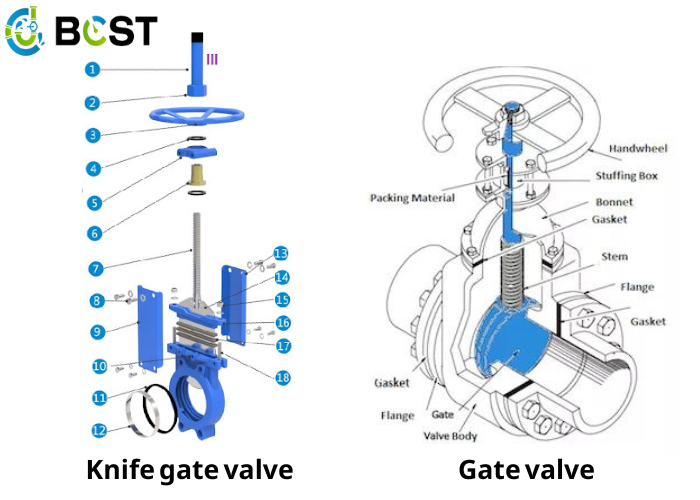
Knife gate valves and gate valves are two common types of valves in the industrial field, they have some differences in application areas, structure, function.
I. Application areas.
Knife gate valves are typically used in liquid, slurry and powder applications, including pulp and paper, bulk handling, mining, food, beverage, chemical and wastewater treatment, and are primarily designed for switching and isolation.
Whereas gate valves are typically used in potable water mains, distribution networks and potable water pumping stations.
II. Function
A knife gate valve is a valve that uses a knife plate parallel to the direction of fluid flow to control the flow of fluid. The knife plate of the knife gate valve is perpendicular to the direction of fluid flow in the channel. When the knife plate is fully open, the fluid can pass freely through the valve. When the knife plate is completely closed, the valve will cut off the fluid to realize the closed state. The knife plate can be manually or electrically controlled, with the advantages of rapid switching and closure. Knife gate valves are commonly used in piping systems that require rapid fluid shutoff, such as sewage, cleaning and emergency shutoff.
And gate valve is a kind of valve that uses a gate to control the flow of fluid. The gate slides open and closed in the direction of fluid flow. When the gate is raised to the top of the passageway, fluid can pass through the valve smoothly. When the gate is lowered to the bottom of the channel, the valve closes completely, shutting off the fluid. Gate valves are suitable for use in systems where the flow rate needs to be regulated and the pressure needs to be adjusted. Due to the slow movement of the gate up and down, gate valves are not suitable for rapid shutoff of fluids as compared to knife gate valves.
III. Structure
There are some differences in the structure of the two types of valves. Knife gate valves have a thinner knife plate that takes up less space and opens and closes faster. The knife plate is usually at a right angle and an O-ring is used to ensure complete sealing of the valve. Gate valves, on the other hand, have a thicker gate plate that is usually flat or trapezoidal in shape to ensure complete opening or closing of the fluid passage. A metal-to-metal face seal is usually used for the gate seal, and lift is usually controlled by a screw above the valve.
The selection of knife gate and gate valves depends on the requirements in a particular application. If there is a need to shut off the fluid quickly, a knife gate valve is a better choice. Knife gate valves are also easier to service and replace knife plates than gate valves because the plates are thinner and smaller. However, where flow and pressure need to be regulated, gate valves are a more suitable choice. Gate valves seal better and provide more precise flow control.

IV. Sealing
Gate Valves: Most gate valves use forced sealing, when closed, you need to rely on external forces to press the gate to the valve seat to ensure that the sealing surface of the sealing.
Knife gate valve: knife gate valve has self-sealing characteristics, closing the sealing surface can rely only on the medium pressure to seal. The medium pressure presses the sealing surface of the gate to the valve seat on the other side to ensure effective sealing.
Ⅴ. Conclusion
To summarize, one of the significant differences between gate valves and knife gate valves is that knife gate valves usually have a sharp disc to help cut off slurry/viscous media. Additionally, knife gate valves are more compact as they have a shorter face-to-face length compared to gate valves with wider dimensions. This makes knife gate valves lighter in weight and smoother in profile, making them a more desirable choice in many applications. Knife gate valves are suitable for applications that require rapid shutoff of fluids, while gate valves are suitable for flow and pressure regulation. Depending on the specific application requirements, choosing the right type of valve can ensure proper system operation and effective fluid control.
BCST knife gate valves are light and flexible in operation, small in size, smooth in passage, low flow resistance, light in weight, easy to install and dismantle, If you are interested in our products, please log on to our web site (https://www.bcstvalve.com), welcome to contact us.






